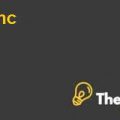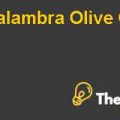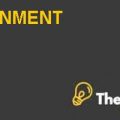Webasto Roof Systems Americas: Leadership through Change (A) Case Study Solution
VRIO Analysis
The value chain is one of the most effective and valuable tool that is widely used to protect and uncover the capabilities or resources that gives long term competitive advantage to company. The identification of the advantages or differentiators helps the company in determining how to inform the strategic decisions that would shape the fate or organization(Patel, 2017).
| Resource/ Capability | Valuable | Rare | Difficult to Imitate | Exploitable by Organizations | Competitive Implications |
| Strong market presence | Yes | Yes | No | Yes | Temporary competitive advantage |
| Leadership through change | Yes | No | No | Yes | Competitive Parity |
| Strong management team | Yes | Yes | No | Yes | Temporary competitive advantage |
| Merger and acquisition | Yes | Yes | No | Yes | Temporary competitive advantage |
| Strong mission | Yes | Yes | Yes | Yes | Sustainable
competitive advantage |
| Automotive innovation | Yes | Yes | Yes | Yes | Sustainable
competitive advantage |
Situational Analysis
Evaluation of North American Automobile Industry
The sales and revenues of WRS AM are highly dependent on the prosperity of the automobile industry as a whole and the North American automotive industry specifically. One of the major causes of the operational and financial challenges faced by the company is the series of unfortunate events that affected automotive industry and resulted in the reduction of the demands for new vehicles.
The first ever economic downturn faced by the automotive industry was during 2003 and 2008 when the crude oil prices was increased rapidly. Stability in the crude oil prices ensures the purchase of new automobiles, hence ensure the demand for the roof systems by OEMs. From 1980s to 2003, the crude oil prices remained stable with an average price of $25/barrel, after that due to increased tensions in the Middle Eastern region, the prices was more than doubled, with a price of $60/barrel in 2005. The prices were then peaked in 2008 with a price of $145/barrel. This rapid increase in crude oil prices reduced the demand for new vehicles, which ultimately reduced the demand for automotive parts.
Another economic downturn which lead to the overall decline in the automotive parts industry was the financial crisis 2007 to 2010. The downfall of the real estate market, which fueled the economic growth in the US for prior half decade, resulted in declining lending activities in the US including lending for purchase of new vehicles. This reduced the overall demand for new vehicles in the US from annual vehicles sales of 16.1 million units in 2007 to only 10.4 million units in 2009 as shown in the Case Exhibit 8.
Although, the overall automotive industry was suffering during the financial crisis, however, Webasto Group was one of the few Tier 1 automotive suppliers, who went through the crisis without any additional money losses. However, the performance of different division was different during the crisis, and as the WRS AM division was not a top performer, the division suffered a lot during the economic downturns.
However, currently, the US automobile industry has revived from the financial downturn due to the loosing credit conditions and increasing consumer confidence with a demand for replacing old vehicles with new one.
The overall market conditions of North American Auto Industry can be analyzed by the four charts given in the Exhibit 1. From the first and second chart, which shows the sales of the US light vehicles, it could be seen that with a rapid decline in the sales during 2008 and 2009, the sales are again increasing with a substantial growth. From the third chart, which shows the miles driven per vehicle and the average fleet age, it could be determined that the miles driven per vehicle are declining at a constant rate due to the higher fuel efficiency standards. From the fourth chart, which shows the market share of various prominent players in the industry, it could be determined that the major players in the North American Automobile Industry include; General Motors, Ford and Toyota. (Ro, 2014)
Leadership Crisis
The main reason, due to which the WRS AM division suffered during the economic downturns was the change of leadership. In 2007, the long-time CEO of WRS AM was replaced by a sales-minded Dean Whitney. In his early stages, he realized by the changing economic indicators, that the automotive industry was in great trouble. Before the economic downturns, the company was quite profitable with high employee morale, however, with the changing economic scenarios, employees were worried that how a sales minded new CEO would handle the crisis.
At his early stage, Whitney handled the situation well with the increase in sales during 2007 to 2008 with a high level. However, the positive results were short lived and soon the executives started notifying inefficiencies in the operational levels. The company soon started running losses at the end of 2011 after a breakeven point between 2010 and 2011. In 2012, again a new CEO was hired with the replacement of Whitney with Albert Schmidt, to make the company profitable again.
Albert Schmidt made certain projections related to his initial fiscal years 2012 and 2013. He projected that in 2012 the company would have a net loss of $5 mm and it would be brought again to breakeven in 2013. However, these projections were proved to be wrong with an actual net loss of $22 mm and $12 mm in the fiscal year 2012 and 2013. This shows the inefficiency of the current leadership to project the financials of the company. Schramm, the new CFO at WRS AM, was highly concerned over the operational issues faced by the current leadership, and demanded support of the global management team of Webasto to review the projections and support the current leadership in moving forward.
Evaluation of the Organizational Culture
Along with the operational issues leading to the inefficient financial performance of the company, there were other problems related to the organizational culture. Almost all of the employees and the leaders at WRS AM had a sense that there was a problem with the employees working at WRS AM. Schramm realized that there was no mutual understanding between various departments, there was a lack of trust and respect for each other. As described by Martin Schroder, there was lack of communication between departments, no responses to others and every department was working independently.
The major cause of developing an organizational culture with low employee morale was the financial downturn during which the company tried to avoid layoffs. Employees were being let to go and the employee turnover rate was high. There was a great change in the organizational culture after the financial downturn. As described by Alessi, an employee working for about 30 years at WRS AM, employees were used to be like friends and they used to for hangout. However, currently the employees even don’t know the names of each other. The community feeling have been lost in the employees after the financial downturn.
According to Alessi, the change of employee’s mood was due to the broken trust. Employees felt that the organization does not care much about them. The company prefers to keep running the operations over the value for its employees. The employees are treated as a person that is to perform a task, and they are supposed to be replaced easily. This attitude of leaders has brought the negative employee morale.
Another employee, Garrard believed that the attitude of the management with lack of communication with subordinates was partly responsible for developing the organizational culture with employee morality and interest.
Adam Hodge, who was moved from the Webasto UK to WSR AM in 2012 described his views about the organizational culture of the company that 2012 was the regression of the culture. He gave number of 1 or 2 out of 10 to the employee mood at that time and was thinking to move back to US. According to Hodge, the major causes for the development of this kind ok organizational culture was the lack of transparency, a lack of trust and isolation between various departments and the management team itself...........
This is just a sample partical work. Please place the order on the website to get your own originally done case solution











